Kobe beef, known for its marbled fat and intense flavor, has been a delicacy in Japan for centuries. The secret to this tender and juicy beef is the way it is raised. Kobe beef comes from a specific strain of Wagyu cattle specially bred and fed a strict diet. The result is a unique flavor and texture that you won’t find in other breeds or even other types of Wagyu.
In this article, we will explore how is Kobe beef raised and what makes it so special compared to other types of beef. We’ll discuss the breed, feed, environment, aging process, and more to give you an in-depth look at one of the world’s most prized meats.
What is Kobe Beef?
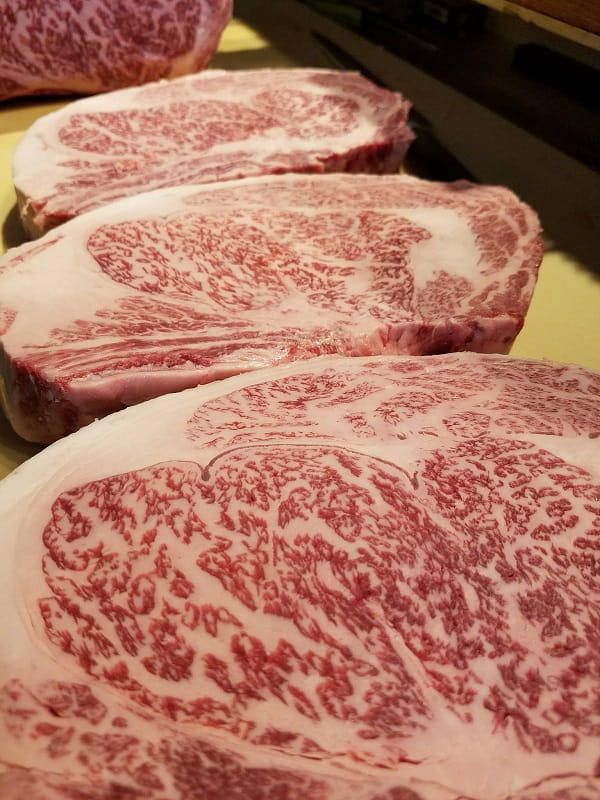
As someone with experience and expertise in the culinary world, I often get asked about Kobe beef. And while it may seem like a simple question, the answer is quite complex.
First and foremost, it’s essential to understand that true Kobe beef comes from a specific breed of cattle, Tajima-guy, raised in the Hyogo prefecture of Japan. These cattle are raised in a very specific manner, with a focus on quality over quantity. They are fed a special diet, given regular massages to increase blood flow, and even listened to music to help reduce stress.
The result is incredibly tender beef with a melt-in-your-mouth texture unlike any other. It’s also marbled with fat delicately and flavorful, making it a true delicacy that is highly sought after by food enthusiasts and chefs alike.
But here’s the thing – not all beef labeled as “Kobe” is authentic. The majority of what you’ll find in the United States is likely not the real deal. Due to regulations by the Japanese government, only a limited amount of Kobe beef is exported each year. Many restaurants and retailers use the term “Kobe” to refer to other types of high-quality beef, such as Wagyu or Angus.
So, how can you tell if you’re getting the real thing? Look for a certification from the Kobe Beef Marketing & Distribution Promotion Association, which ensures that the beef is authentic and has met strict standards for quality and production.
True Kobe beef is best enjoyed in terms of preparation with minimal seasoning and cooking. A quick sear on a hot grill or skillet is all needed to showcase the meat’s natural flavor and texture. And while it may come with a hefty price tag, the experience of tasting authentic Kobe beef is truly one-of-a-kind.
What Makes Kobe Beef Unique And Highly Sought After In The Culinary World?
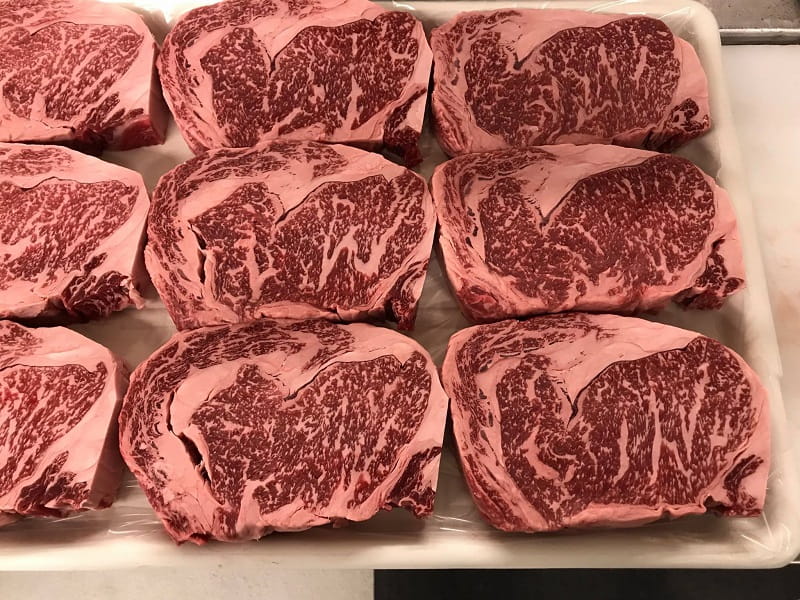
Kobe beef is considered a highly sought-after delicacy in the culinary world due to its unique characteristics and flavor profile.
- One of the key features that set Kobe beef apart is its incredible marbling, which refers to the ratio of intramuscular fat within the meat. This high marbling ratio gives Kobe beef its distinct buttery, melt-in-your-mouth texture and contributes to its exceptional flavor.
- The meat is also known for its intense, rich taste, making it a true indulgence for meat connoisseurs.
- Additionally, Kobe beef comes from a specific bloodline of certified cattle in Japan’s Kobe region, making it a rare and exclusive item. Due to its limited availability, the demand for Kobe beef far outweighs the supply, contributing to its high price tag.
Because of these factors, Kobe beef has become synonymous with culinary excellence and is often regarded as the crème de la crème of beef. Whether prepared as a steak, sukiyaki, shabu-shabu, or even consumed as sashimi, Kobe beef offers a truly unique and luxurious dining experience.
How Do Traceability And Certification Play A Role In The Kobe Beef Industry?
Traceability and certification play a crucial role in the Kobe beef industry. The Kobe Beef Marketing and Distribution Promotion Association has set stringent criteria that must be met for beef to be classified as Kobe beef. To ensure traceability, each carcass of Tajima gyu cattle used for Kobe beef must meet these criteria.
The Japanese government has implemented regulations and created the Food Safety Commission to address food safety concerns. Traceability systems have been put in place to track the movement of animals and identify herd cohorts in case of diseases or safety issues. Cattle in Japan are identified with individual identification numbers, and data on each animal’s birth, sex, breed, owner, location, and slaughter date are recorded. From the farm to retail sale, traceability information is required, and penalties are imposed for noncompliance.
The Ministry of Agriculture, Forestry, and Fisheries introduced a Japan Agricultural Standard program to certify the traceability of imported beef. Retailers also utilize traceability as a marketing tool to build consumer confidence. Supermarkets have incorporated traceability into their assurance programs, allowing customers to access information about the beef they purchase, including production records, BSE testing certificates, and livestock producer details. Some retailers provide information about the origin and production methods of various types of meat, and consumer interest in traceability also extends to processed products.
While domestic Wagyu beef commands higher premiums, market experts believe exporters with fully traceable systems may succeed in the Japanese market. However, obtaining premiums for imported meats, particularly beef, is challenging due to consumer bias favoring domestic products.
Differentiating imported meats through non-commodity niche markets, such as antibiotic-free and non-genetically modified options, could enhance competitiveness. Japanese importers are open to considering alternative traceability systems that focus on high production and manufacturing standards linked to food safety.
Certification programs for pork are also being considered, and the goal is to purchase meats from suppliers who offer low-cost products with marketable assurance programs. While commodity products dominate Japanese imports, there is increasing demand for higher-value differentiated products in the retail and hospitality sectors.
How is Kobe Beef Raised?
Kobe beef is raised uniquely to ensure its exceptional quality. To be considered Kobe beef, it must come from the Tajima-gyu breed of cattle born, raised, and slaughtered in Kobe, Japan. These cows are a specific strain of the Wagyu breed and are carefully bred for their superior meat marbling.
The raising process starts with specialty breeders who raise the cows until they are between seven and 10 months old. At this stage, they are sold to a farmer with a birth certificate certifying their pure bloodline. The cost of each cow can be as much as $30,000, which is significantly higher than the typical American Angus.
Once in the care of farmers, Kobe cows are provided with a luxurious diet to achieve the desired weight ratios and fat marbling. They are fed multiple times daily with chopped grain plants, corn, and other nutrient-rich foods. Vitamins, minerals, and even oils are added to their diet to soften the fat on their bodies and allow it to spread evenly. While cows are generally calm within a Kobe farm, the freedom to trot about grass fields can vary depending on the farm. Some cows have more opportunities to roam than others, affecting their overall experience.
There are concerns about potentially overfeeding cows to the point where they become mostly fat. However, farmers physically help the cows distribute the fat to ensure the right balance. The goal is to achieve a high amount of marbled fat, which gives Kobe beef its unique taste and texture. The cows are raised in a nearly stress-free environment with plenty of food, and the farmers are careful to avoid causing unnecessary anxiety. This level of care and coddling is believed to contribute to the better taste of Kobe beef.
Kobe beef is a highly prized delicacy that is difficult to raise and expensive. Japan does not allow the export of its livestock, making Kobe beef hard to find in other countries. The extensive and costly raising process and government tariffs significantly contribute to the high cost of Kobe beef. Additionally, the preparation and mastery of using meat at restaurants also impact the price. Despite the expense, Kobe beef offers a unique and delicious taste for those with refined palates.
In conclusion, Kobe beef is raised meticulously, starting with the specialty breeding of Tajima-gyu cows. These cows are fed a nutritious diet and raised in a nearly stress-free environment. The result is meat with abundant marbling, a smooth buttery taste, and a consistent texture. The stringent raising process and limited availability in the market contribute to the high cost of Kobe beef. However, it is a worthwhile investment for those who appreciate exceptional quality meat.
Do Kobe Cattle Graze On Natural Pastures?
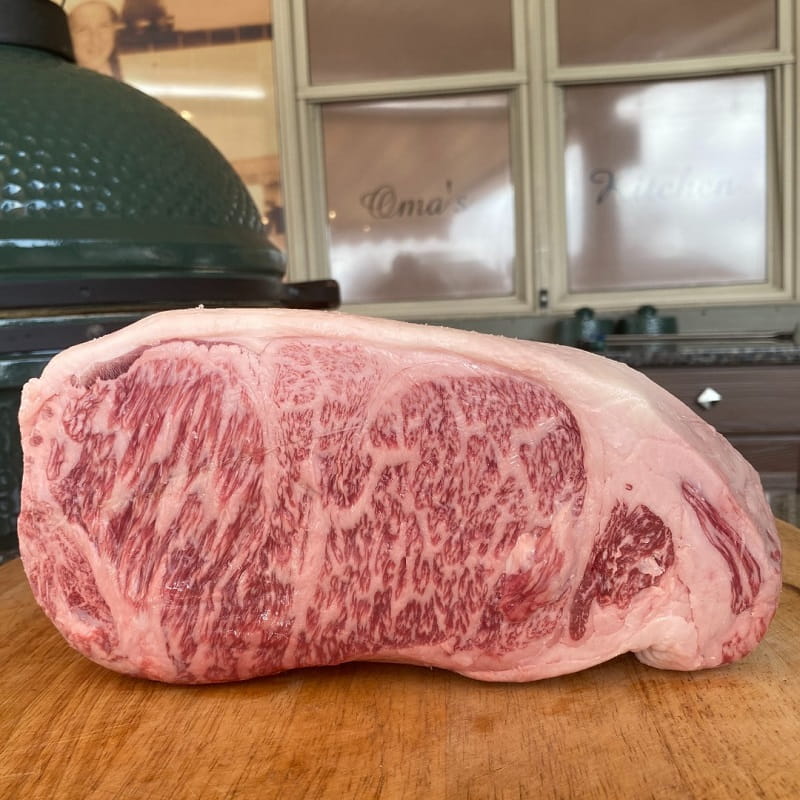
It is important to note that Wagyu cattle, including Kobe cattle, graze for food in pastures. Unlike beef cattle, they live naturally and have plenty of pasture to graze in.
Although Japan has declared Wagyu cattle a national treasure and ceased all exports, American Wagyu farms have purebred Wagyu cattle. These farms raise their cattle on natural pastures and feed them a grass-fed diet. This ensures that the meat from these cattle carries the consistent meat characteristics that have made the breed famous.
Are There Strict Regulations In Place To Govern The Production Of Kobe Beef?
Yes, there are strict regulations in place to govern the production of Kobe beef. All Kobe Beef cattle are born and raised in Japan’s Hyogo prefecture under the strictest breeding guidelines. For beef to qualify as Kobe, it must meet very strict standards. The cattle must be 100% pure Tajima, a strain of black Wagyu, born within the Hyogo prefecture. It must be processed in a Hyogo slaughterhouse and pass a strict government grading exam.
The Japan Meat Grading Association also has strict rules and standards determining whether cattle can be classified as Kobe beef. These regulations ensure that only the highest quality beef that meets the specific criteria can be labeled as Kobe beef.
Read more:
- Smoke Brisket Fat Side Up Or Down Pit Boss
- How Hot Should The Grill Be For Steak
- Why is Wagyu So Expensive
- Wagyu Vs Angus
How Long Does It Take To Raise A Kobe Beef Cattle From Birth To Market?

Raising Kobe beef cattle from birth to market takes careful attention and adherence to specific guidelines. Firstly, the cattle must be born and raised in Hyogo Prefecture in Japan. This region is known for its strict standards and is essential for the Kobe beef designation. The cattle are typically born and raised by specialty breeders until they are seven to ten months old. At this point, they are sold to farmers along with a birth certificate.
Once in the hands of the farmers, the cattle are raised with great care and attention. It takes several years for the cattle to reach maturity and develop the desired marbling and flavor that Kobe beef is known for. The intense marbling, a key characteristic of Kobe beef, typically occurs around months 28 to 36 of the cattle’s life.
Compared to traditional cattle, typically slaughtered at 18 months, Kobe beef cattle take much longer to reach the desired age for slaughter. They must reach at least three years old before they are ready. During this time, they must graze to ensure a high omega-3 content and are slow-growing.
When estimating the timeline for raising Kobe beef cattle, it is important to note that variances can occur within Wagyu breeds and bloodlines. Also, feeding protocols and the time the cattle are fed can impact the timeline. However, it takes several years of careful raising and feeding to bring Kobe beef cattle from birth to the market.
Raising Kobe beef cattle is meticulous and requires adherence to specific guidelines and standards. From being born in Hyogo Prefecture to being raised with care and attention, it takes time, patience, and expertise to ensure that the cattle develop the desired marbling and flavor that Kobe beef is renowned for. And this process typically takes several years before the cattle are ready for market.
Can Kobe Beef Only Be Raised In Japan, Or Is It Possible To Raise It Elsewhere Around The World?
Based on factual data, authentic Kobe beef must come from Tajima-gyu cattle born, raised, and slaughtered in Hyogo Prefecture, Japan. These cattle have to be fed a specific diet consisting mainly of grains and grass. Therefore, authentic Kobe beef can be produced only in Hyogo Prefecture under strict breeding guidelines.
While farms in other parts of the world may attempt to mimic the Japanese cattle-raising practices, by definition, Kobe beef can only come from Japan. Under Japanese law, Kobe beef can only be sourced from Hyogo Prefecture, where no slaughterhouses outside the region are approved for processing Kobe beef.
Attempting to replicate the production of Kobe beef elsewhere does not meet the stringent requirements and regulations set forth by Kobe Beef Marketing & Distribution Promotion Association.
Therefore, it can be concluded that authentic Kobe beef is exclusive to Japan and cannot be raised worldwide.
What Type Of Feed And Care Do Kobe Beef Cattle Require To Maintain Their Distinct Flavor And High Quality?
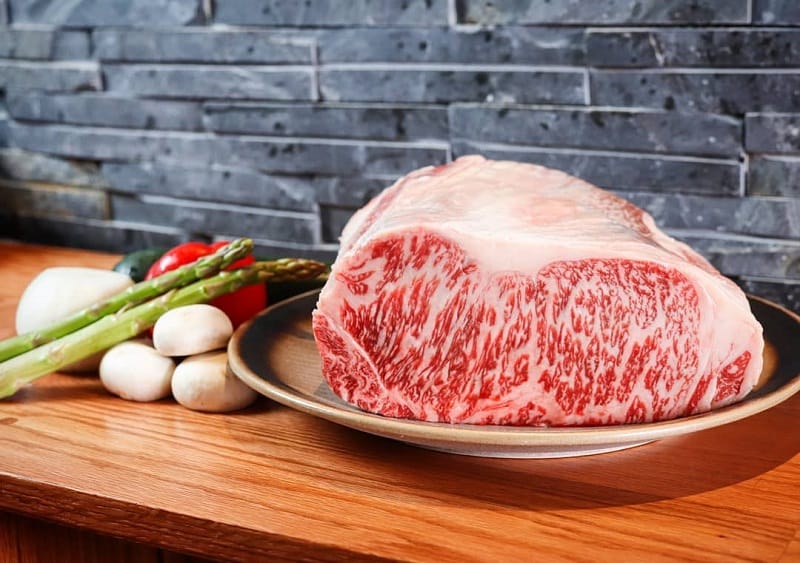
Kobe beef cattle farmers focus on providing the highest quality feed and care to maintain the beef’s distinct flavor and high quality. The cattle are given a diet that consists of grains and grasses sourced exclusively from within the Prefecture. This strict feeding regimen ensures the beef achieves its unique taste and tenderness.
Additionally, the cows are massaged with sake, a traditional practice believed to enhance their meat quality. The cattle are fed forage, grasses, rice straw, corn, soybeans, wheat bran, beer, and even sake to ensure the utmost flavor. This diverse and flavorful diet contributes to the rich taste of Kobe beef.
Furthermore, the cattle are raised in a stress-free environment to promote optimal growth and well-being. This careful attention to the feed and care of Kobe beef cattle ensures the production of top-quality and highly sought-after beef.
How Does The Strict Grading System In Japan Ensure Only The Highest Quality Kobe Beef Is Sold To Consumers?
The strict grading system in Japan is crucial in ensuring that only the highest quality Kobe beef is sold to consumers. This grading system, established by the Ministry of Agriculture and regulated by the Japan Meat Grading Association (JMGA), assesses Wagyu carcasses objectively and comprehensively. The grading process covers the yield grade and the quality of the beef.
In Japan, carcasses are categorized into one of the 15-grade categories, with A5 being the highest and C1 being the lowest. The grading is based on marbling, color, texture, and overall quality. The grading system determines the grade for Kobe beef, a type of wagyu beef. To be classified as A5 Wagyu, the meat must be graded as Grade A for yield and Grade 5 for firmness, color, and texture. This ensures that only beef of exceptional marbling and quality is considered Kobe beef.
The strict grading system implemented in Japan guarantees fair trading and maintains the reputation of Kobe beef as a premium and sought-after product.
How Do Factors Like Climate And Geography Impact The Flavor And Quality Of Kobe Beef?
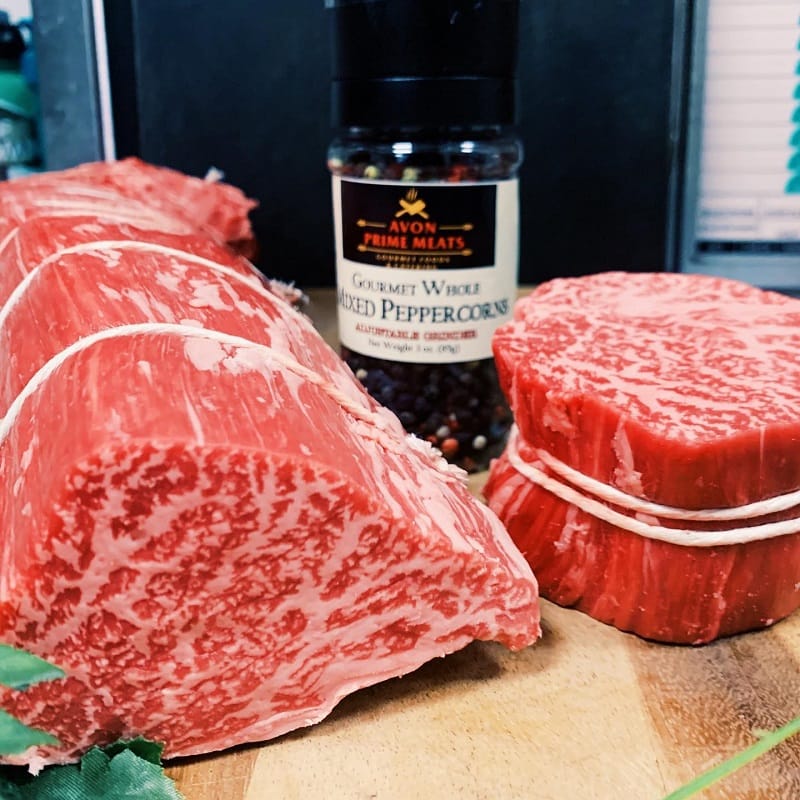
The climate and geography play a significant role in impacting the flavor and quality of Kobe beef.
- First and foremost, the geographic indicator regulation by the Japanese government ensures that Kobe beef is produced in a specific region known for its superior quality. This region is characterized by mountainous terrain, which isolates it from the surrounding areas. The isolation results in a unique and stress-free environment for the cattle, contributing to the exceptional quality of the beef.
- Additionally, the region’s rich environment allows for the breeding of Wagyu cattle, known for their intense marbling and superior taste. The diet and stress-free environment further enhance the flavor of Kobe beef.
- Moreover, the climate in this region also plays a role. The specific temperature and humidity levels in the region create ideal conditions for the growth and development of the cattle.
Combined with the meticulous grading process that considers factors such as marbling, meat, fat color, brightness, and texture, these factors result in the complex and subtle flavor of Kobe beef. The flavor and quality of Kobe beef are truly a product of the unique climate and geography of the region.
FAQs About How is Kobe Beef Raised
How Is A Stress-Free Environment Maintained For Kobe Cattle?
Maintaining a stress-free environment for Kobe cattle is crucial in ensuring their well-being and meat quality.
Japanese farmers go to great lengths to create a calm, serene atmosphere for these prized cows. One key aspect is good handling practices, which minimize stress and anxiety. By understanding the personality of each cow and its compatibility with others, farmers can ensure harmony within the herd and reduce any potential sources of stress.
Additionally, the cows are raised in an environment that limits movement, further contributing to their calmness. The farmers aim to manage the animals’ stress to zero, as stress can lead to increased adrenaline production, tensed muscles, and tough meat. They believe that excess stress can even result in unpalatable meat.
By providing a stress-free environment, the farmers help promote the well-being of Kobe cattle and maintain the complex and subtle flavors for which this premium beef is known.
Is It True That Kobe Cattle Receive A Hand Massage?
I can confirm that there is some truth to the claim that Kobe cattle receive hand massages. However, it is important to note that this practice is not exclusive to Kobe cattle and is also observed with other Wagyu breeds in Japan. The purpose of these massages is not to tenderize the meat, as commonly believed, but rather to relieve stress and muscle stiffness in the cattle. This is because the farmers believe that keeping the cattle relaxed and comfortable positively affects the eating quality of the meat.
It is also worth mentioning that these massages are given to cows that don’t roam freely to relax their muscles. So while the notion of massaging cows may seem peculiar, it is a common practice in Japan for the well-being of the animals rather than a technique to enhance the tenderness of the meat.
Are Kobe Cattle Subjected To Daily Exercise Routines?
No, Kobe cattle are not subjected to daily exercise routines. Kobe cattle, also known as Wagyu cattle, are a breed of cattle that originated in Japan. These cattle are renowned for their high marbling level, giving the meat a unique flavor and tenderness.
To achieve this desired marbling, Kobe cattle are raised with a focus on a high-fat diet and minimal physical activity. This allows the fat to distribute evenly throughout the muscle fibers, resulting in the desired marbling pattern. The cattle are typically confined to small spaces or individual pens to minimize their movement and prevent excess fat burning. This sedentary lifestyle is an essential aspect of the breeding process and contributes to the well-known characteristics of Kobe beef.
How Are Kobe Cattle Ensured Humane Treatment Throughout Their Lives?
Wagyu farmers take great pride in providing their cows with a comfortable and humane environment. These cows are given plenty of space in their pens and are also allowed to roam outside on the pasture to graze freely.
To ensure their well-being, the cows are fed only grains and grasses from within the Prefecture during their life. Regarding processing the cattle, they are taken to approved slaughterhouses in Hyōgo. This careful handling reflects the commitment to humane treatment throughout the entire process.
Another unique aspect of raising Kobe cattle is that these animals are kept primarily indoors in feedlots during their fattening period. This helps minimize their movement and exercise, leading to the distinct marbling and tenderness of the meat.
Additionally, the cows are given beer and massages. While some claim these practices are rooted in traditional Japanese ranching methods, the direct impact of beer and massages on the cows’ welfare remains uncertain. Nonetheless, the focus on creating a zen-like existence for the cows is a testament to the dedication of Japanese cattle breeders.
Overall, ensuring humane treatment for Kobe cattle is a top priority for farmers and contributes to the high-quality meat that is widely acclaimed.
Conclusion
In conclusion, Kobe beef is raised very specifically and meticulously. From the breed of cattle used to how they are fed, handled, and processed, every aspect of the process is designed to produce the most tender, flavorful meat possible. It’s no wonder that Kobe beef is considered a luxury item with a price tag to match. But for those who truly appreciate the art of fine dining, it’s well worth the investment. So the next time you have the opportunity to try Kobe beef, savor every bite and appreciate the incredible effort that went into producing it.
Do you have any questions about how is Kobe beef raised? Let us know in the comments below.
References:
- https://wagyu-jfoodo.jetro.go.jp/europe/uk/story6/index.html
- https://www.card.iastate.edu/iowa_ag_review/fall_03/article2.aspx
- https://truorganicbeef.com/blogs/beef-wiki/the-dark-world-of-wagyu-beef

Hey readers! Chip Holland here, and I’m a Manager of this website. My passion for writing about it only matches my passion for BBQ. Follow my blog for mouth-watering recipes, tips, and tricks for the perfect smoke, grill, and BBQ. I’m sure you won’t be disappointed!
